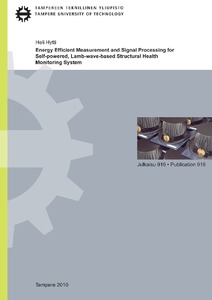Energy Efficient Measurement and Signal Processing for Self-powered, Lamb-wave-based Structural Health Monitoring System
Hytti, Heli (2010)
Hytti, Heli
Tampere University of Technology
2010
Automaatio-, kone- ja materiaalitekniikan tiedekunta - Faculty of Automation, Mechanical and Materials Engineering
This publication is copyrighted. You may download, display and print it for Your own personal use. Commercial use is prohibited.
Julkaisun pysyvä osoite on
https://urn.fi/URN:NBN:fi:tty-201010081331
https://urn.fi/URN:NBN:fi:tty-201010081331
Tiivistelmä
Ultrasonic waves have been applied in non-destructive testing for decades. Development of new sensors and transducers for actuating and detecting the ultrasonic guided waves has made the ultrasonic structural health monitoring more viable both technically and economically than it has been in the past. However, from both the economical and technical point of view, the wiring needed for powering the measurement system and transferring the collected data is seldom acceptable. The demand for wireless and self-powered, energy efficient systems is continuously increasing.
This thesis contributes to development of a structural health monitoring system suitable for continuous use in industrial applications. The suggested monitoring system integrates a well-known piezoelectric actuator and sensor technique for Lamb wave based defect detection with wireless data transfer, power harvesting and data analysis in an affordable manner. Low power production in the local power harvesting dominates the design of both the components and the operating principle of the integrated system.
The main contributions of this thesis are 1) specifications for a new, energy efficient measurement system, where only a few key samples are measured from the piezoelectric transducer response to ultrasonic guided waves and the response is then reconstructed from these samples, 2) repeatability analysis of the measurements and the defect indicating parameters calculated from them, and 3) enhanced defect detection and location method based on changes in variance of the response and the repeatability of defect location. The defect location method is based on the reconstruction algorithm for probabilistic inspection of defects suggested by Zhao et al. [Zha2007a] and developed further for improved function with small number of piezoelectric transducers and minimized amount of measurement data.
This thesis contributes to development of a structural health monitoring system suitable for continuous use in industrial applications. The suggested monitoring system integrates a well-known piezoelectric actuator and sensor technique for Lamb wave based defect detection with wireless data transfer, power harvesting and data analysis in an affordable manner. Low power production in the local power harvesting dominates the design of both the components and the operating principle of the integrated system.
The main contributions of this thesis are 1) specifications for a new, energy efficient measurement system, where only a few key samples are measured from the piezoelectric transducer response to ultrasonic guided waves and the response is then reconstructed from these samples, 2) repeatability analysis of the measurements and the defect indicating parameters calculated from them, and 3) enhanced defect detection and location method based on changes in variance of the response and the repeatability of defect location. The defect location method is based on the reconstruction algorithm for probabilistic inspection of defects suggested by Zhao et al. [Zha2007a] and developed further for improved function with small number of piezoelectric transducers and minimized amount of measurement data.
Kokoelmat
- Väitöskirjat [4773]
